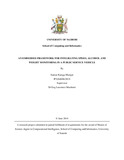| dc.description.abstract | Road Carnage is a great problem in our Kenyan roads. To reduce this, the government have tried
to introduce regulatory laws for drivers on the roads. For instance, all public service vehicles
except taxi cabs and commercial vehicles exceeding 3.048 tonnes must be fitted with a wellfunctioning
and inspected Speed Limiter. Heavy vehicles are also required to record their
weights in weigh bridges in an attempt to reduce overloading. To curb drunk driving, traffic
officers’ takes impromptu alcohol level tests on roads that are notorious for drunk driving.
This research identified a problem with the introduction of these laws. There was no integration
framework that could be used to monitor these 3 main causes of road accidents (Over speeding,
drunk driving and overloading). The research then tried to come up with an integration
framework that can do the monitoring
To solve the main research problem of lack of an integration framework, the research worked
with 3 clear objectives. First, a suitable integration framework was designed. Secondly, a
prototype based on the chosen framework was developed. Lastly, some data was simulated in
order to test and evaluate the prototype
Through previous research works, this research project identified that the framework for onboard
Network Level Diagnostics (Suwatthikul, 2008) could be used with a few modifications.
This framework constitutes of 3 main parts; Network Interface Module (NIM), Diagnostics
Module and a Fault and Knowledge database. For this research, NIM was used to collect data
from Speed Limiters, Weigh Bridges and Alco blows. Diagnostics module was replaced by a rule
based control system that acted as the central control. The fault database was used to record all
the instances collected, while the Knowledge database was omitted.
After designing the framework, a prototype was developed on the Arduino framework. The
Speed Limiter and a Weigh bridge data was generated by varying a potentiometer. To capture
alcohol levels, an inbuilt Alco blow was developed. Since speed limiters store data in files, the
values got from the potentiometer that was mimicking a speed limiter were saved in a file.
Different formats were used in order to cater for various formats used by Speed limiter vendors.
Data was then simulated by varying the potentiometers and alcohol levels entering the device.
This data was saved to a permanent log file for use in future .To verify that the device was working correctly, some limits were set and verifications were made to confirm that the device
was correctly checking if those limits were exceeded or not. An example of a limit set used was
Speed=80 km/h, weight= 1000kg and Alcohol Content=30 Micrograms.
The results of this tests showed that the device correctly identified when the limits were
exceeded or not. This was verified from the stored logs and also a third party system that was a
Ticketing/Monitoring system.
This project showed that this device could be used on the roads. With proper implementation it
would be more effective to curb some of the social problems on the Kenyan roads like bribes,
some culprits avoiding apprehension and many more. This technology would be better that using
distinct devices since it monitors all the 3 main parameters contributing to roads accidents
together.
This project was an achievement since it solved the problem that was currently there of lack of
an integration framework for Speed, alcohol and Weights monitoring. Integration of these 3
factors in one device is therefore possible. This was the new knowledge that the project provided
This research project was similar to previous works on Hardware Integration frameworks. In all
of them, a suitable framework was chosen, based on previous research, a hardware device was
then developed , based on the proposed framework and lastly, the device was tested to verify if
the research problem had been solved. It also discussed some of the issues in integration
frameworks, notably, data formatting, dataintegration, system redundancy, data integrity and
reliability. | en_US |

